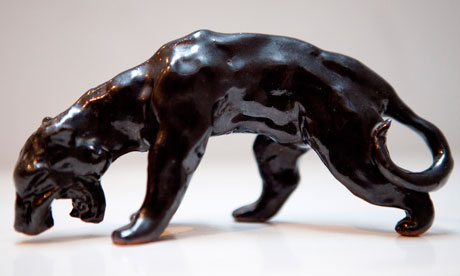
Ted Hughes's fascination with jaguars inspired some of his verse, but it was little known until now that it also led him to create two sculptures.
One of the sculptures, pictured for the first time in today's Observer, is seen by experts as a self-portrait of a complex man who struggled against his demons, using animals and the dark forces of nature as metaphors for human life.
Hughes made the sculpture in 1967 – four years after the death of his wife, American poet Sylvia Plath, who took her own life, aged 30, after being abandoned by Hughes for his lover Assia Wevill. The sculpture, which Hughes gave to his brother, is particularly striking because he branded the jaguar's forehead with the letter 'A', possibly for Assia or "adulterer", as recalled in Nathaniel Hawthorne's The Scarlet Letter, in which a woman is sentenced to wearing the letter A around her neck.
Such was Hughes's eye for detail and understanding of the animal's anatomy that every muscle and bone is there. Although a mere seven inches long, it is a powerful depiction.
Jonathan Bate, a leading academic who is writing a Hughes biography for publication in 2013, told the Observer of his excitement at seeing the sculpture. He said: "The idea of the jaguar was very powerful to him, so it is wonderful that there is this sculpture. I think that the jaguar, to him, was – like the tiger to William Blake – Tiger, Tiger Burning Bright – a raw kind of creative force and animal passion."
After graduating from Cambridge in 1954, Hughes had a variety of temporary jobs, including a period at London Zoo where he observed the jaguar's behaviour. In one of his early poems, The Jaguar, he wrote: "His stride is wildernesses of freedom:/ The world rolls under the long thrust of his heel." Bate said: "The jaguar obviously remained an obsession… because there's a later poem called Second Look at a Jaguar, and a much later poem that's never been published called Jaguar Skin." Bate hopes to publish at least some of it: "It's a very fine poem."
Hughes was poet laureate from 1984 until his death in 1998 from cancer. His intimate collection of poems, Birthday Letters, in which he broke his silence about his marriage to Plath, was published only months before his death. Theirs was one of the great literary love stories, blighted by tragedy. Some of Plath's fans blamed him for driving her to her death. Plath herself once wrote: "There is a panther stalks me down / One day I'll have my death of him." Assia Wevill also killed herself and her four-year-old daughter, Shura, in 1969, months after Hughes left her.
It was while living with Wevill that Hughes made the two jaguars, which he gave to his sister, Olwyn, and brother, Gerald. Olwyn's is now in a sorry state, but Gerald's has survived in perfect condition. Now aged 90, and living in Australia, he is selling it. Olwyn Hughes said that Gerald is parting with it because "he's absolutely broke". She added: "People used to say [Ted's] poetry was violent. But I think that he wrote so beautifully and powerfully about animals, that it was almost as though the animal was in the room."
Asked whether she sees the sculpture as a self-portrait, she said: "The way it's posed, in tense contemplation and pain, fits with that period after Sylvia died."
Her own jaguar shows another side to Hughes – "running free… [with] none of the tension that there is in Gerald's, but unfortunately it only has one leg".
Rick Gekoski, a London dealer in rare books and manuscripts, has been asked to sell the sculpture. He said: "It seems to me powerful, dark, sexual, predatory, which are terms that have frequently been used to describe Ted Hughes. But it also seems to me to have quite a lot of inwardness and feeling. The head is low rather than high. It doesn't look like an animal that's attacking."

